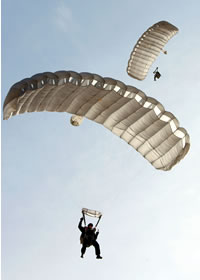Airborne Systems Group demonstrated new parachute delivery systems during the company’s “Airborne Days” demonstration event. Among the highlights were the Advanced Tactical Parachute System (ATPS) slated to replace the US Army’s aging T-10 series non-steerable troop parachutes in use since the 1950’s. ATPS is designed for improved safety, by reducing the rate of descent by 25 percent from 22 feet per second with the T-10 to an average rate of descent of 18 feet per second for a 385lbs Total Jumper Weight. Consequently, the decline in rate of descent will reduce the impact energy by almost 40% to lessen the potential for injury. It has a newly redesigned reserve parachute and an integrated harness system more adaptable for use by a wide range of jumpers (fifth percentile to the 95th percentile soldier).
 Airborne is supplying the U.S. Army’s latest steerable troop parachute, the MC-6 system which is being fielded to replace the U.S. Army’s MC1-1 series of steerable troop parachutes. Several high performance military parachutes were also featured. These included the Hi Glide HAHO (High Altitude, High Opening) system which has the highest gliding capability available and has been adopted by the U.S. Marine Corps, along with the Raider/Intruder System currently under evaluation as a candidate for the replacement of the U.S. Army’s MC-4 Ram Air Parachute System. Airborne also demonstrated the LLP (Low Level Parachute) system, the standard non-steerable troop parachute in the United Kingdom, and the SAP (Steerable Assault Parachute).
Airborne is supplying the U.S. Army’s latest steerable troop parachute, the MC-6 system which is being fielded to replace the U.S. Army’s MC1-1 series of steerable troop parachutes. Several high performance military parachutes were also featured. These included the Hi Glide HAHO (High Altitude, High Opening) system which has the highest gliding capability available and has been adopted by the U.S. Marine Corps, along with the Raider/Intruder System currently under evaluation as a candidate for the replacement of the U.S. Army’s MC-4 Ram Air Parachute System. Airborne also demonstrated the LLP (Low Level Parachute) system, the standard non-steerable troop parachute in the United Kingdom, and the SAP (Steerable Assault Parachute).
 Airborne is offering a new family of GPS guided autonomous parachute delivery systems known as Joint Precision Aerial Delivery System (JPADS). Airborne developed these products as a family of platforms, with varying weights and sizes using the same software platform. With this “family” approach, the user interface on the autonomous guidance units and the mission planer are identical across the various models of “smart” cargo delivery products. Demonstrations were provided for the ARK (Aerial Rescue Kit) and SPARK (Small Pack Rescue Kit) which are the latest technologies used in aerial delivery rescue and survival equipment.
Airborne is offering a new family of GPS guided autonomous parachute delivery systems known as Joint Precision Aerial Delivery System (JPADS). Airborne developed these products as a family of platforms, with varying weights and sizes using the same software platform. With this “family” approach, the user interface on the autonomous guidance units and the mission planer are identical across the various models of “smart” cargo delivery products. Demonstrations were provided for the ARK (Aerial Rescue Kit) and SPARK (Small Pack Rescue Kit) which are the latest technologies used in aerial delivery rescue and survival equipment.
NJ based Airborne Systems has combined the core technologies of four of the world’s leading parachute brands; Irvin Aerospace, GQ Parachutes, Para-Flite and AML (Aircraft Materials, Ltd).



















